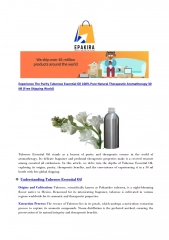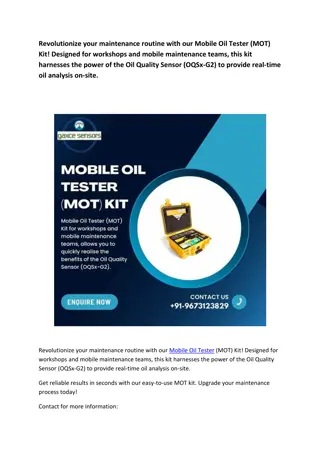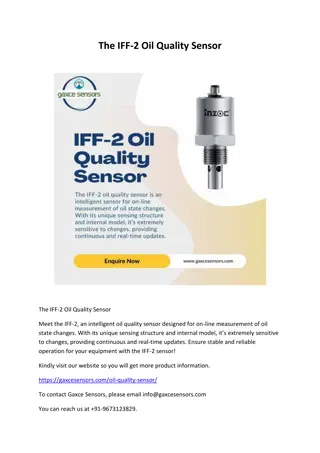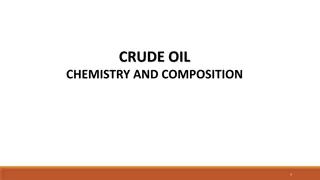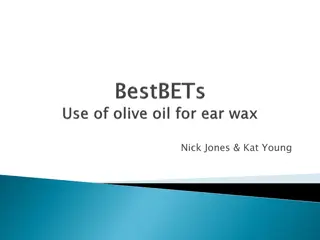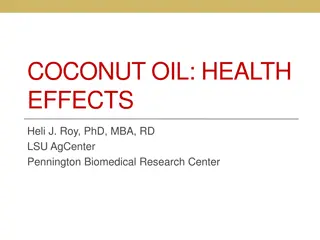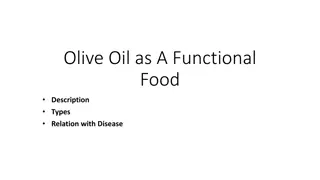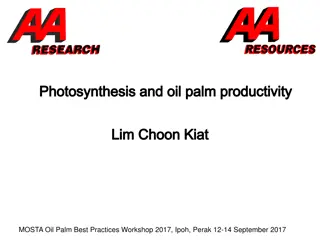Understanding Quality Characteristics of Good Olive Oil
Discover the essential quality characteristics of good olive oil, including factors affecting its quality, basic composition, and parameters influencing its overall acceptability. Learn about the importance of attributes such as free fatty acidity, peroxide value, and sensory scores in determining olive oil quality.
Download Presentation

Please find below an Image/Link to download the presentation.
The content on the website is provided AS IS for your information and personal use only. It may not be sold, licensed, or shared on other websites without obtaining consent from the author. Download presentation by click this link. If you encounter any issues during the download, it is possible that the publisher has removed the file from their server.
E N D
Presentation Transcript
Quality Characteristics of good Quality Characteristics of good olive oil olive oil -DRISHTI MAJITHIA
What is Quality? What is Quality? Definition: The combination of attributes or characteristics of a product that have significance in determining the degree of acceptability of that product by the user (Gould, 1992). The International Olive Oil Council (IOOC, 2001) and the EEC (EC, 1991) have defined the quality of olive oil, based on parameters that include free fatty acid (FFA) content, peroxide value (PV), UV specific extinction coefficients (K232 and K270) and sensory score
Parameters that affect olive oil quality Parameters that affect olive oil quality The following factors play a role in the quality of olive oil produced: 1. Health of fruit (degree of pest and disease infestation) 2. Method and period of post-harvest fruit storage 3. Oil extraction system ( including extraction temperatures) 4. Method and period of oil storage prior to packing 5. Cultivar of olive (type) 6. Climate (latitude of production area) 7. Cultural techniques (irrigation, drainage, pesticide residues, etc.) 8. Soil type 9. Harvesting method 10. Maturity of fruit (time of harvesting) 11. Method of fruit transport 12. Type of packaging 13. Period of storage in final pack prior to use
These factors affect both the quality and keeping quality of olive oils by altering one or more of the following chemical components of the oil: 1. Free fatty acidity (the degree of chemical breakdown of the triacylglycerols) 2. Peroxide value (the degree of peroxidation of the oil) 3. Antioxidant content (the content of polyphenols and tocopherols) 4. Spectrophotometric constants (mainly UV extinction coefficient at 270nm) 5. Fatty acid profile of triacylglycerols (content of oleic, palmitic, linoleic, etc.) 6. Pigment content (chlorophylls and carotenoids) 7. Aroma compounds (alcohols, aldehydes, ketones, esters, phenols, terpenes) 8. Mono- and diacylglycerol content (partially formed triacylglycerols) 9. Sterol content (beta-sitosterol, campesterol, stigmasterol, etc.)
Basic composition of olive oil Basic composition of olive oil Fatty Acids: Fatty acids are simple structures made up of long chains of various numbers of carbon atoms. There are only a few types of fatty acids in olive oil, but the proportions of each strongly influence the characteristics and nutritive value of the oil. Most olive oil fatty acid chains contain 16 or 18 carbon atoms, shown as C16 and C18 respectively. The carbon chains of all fatty acids have a carboxyl group (COOH) at one end. The fatty acid chain for stearic acid (C18) is therefore: Triacylglycerols: In a unit (or molecule) of olive oil, the fatty acids are bound in groups of three together with a unit of glycerol. These units are called triacylglycerol molecules or TAGs. Only when the fatty acids are bound in these small units are they considered to be good quality oil. C-C-C-C-C-C-C-C-C-C-C-C-C-C-C-C-C-COOH
FREE FATTY ACIDS (FFA) AND ACIDITY FREE FATTY ACIDS (FFA) AND ACIDITY The "acidity" in olive oil is the result of the degree of breakdown of the triacylglycerols, due to a chemical reaction called hydrolysis or lipolysis, in which free fatty acids are formed. Oil extracted carelessly and/or from poor quality fruit suffers from a very significant breakdown of the triacylglycerides into fatty acids. These broken off fatty acids are called Free Fatty Acids. Factors which lead to a high free fatty acidity in an oil include fruit fly infestation, delays between harvesting and extraction, fungal diseases in the fruit, prolonged contact between oil and vegetation water and careless extraction methods. The free fatty acidity is thus a direct measure of the quality of the oil, and reflects the care taken right from blossoming and fruit set to the eventual sale and consumption of the oil.
MINOR COMPONENTS IN OLIVE OIL POLYPHENOLS/ANTIOXIDANTS The flavonoid polyphenols in olive oil are natural antioxidants that contribute to a bitter taste, astringency, and resistance to oxidation PEROXIDES Peroxides are the primary products of oxidation of olive oil. Fats and oils such as olive oil are oxidized when they come in contact with oxygen. Oxygen may exist in the headspace of the container and dissolve in the oil. The oxidation products have an unpleasant flavor and odor and may adversely affect the nutritional value of the oil. The more rancid or oxidized the oil, the more peroxides are present. PIGMENTS AND COLOR The unique color of olive oil is due to pigments like chlorophyll, pheophytin, and carotenoids. The presence of various pigments depends on factors such as the fruit ripeness, the olive cultivar, the soil and climatic conditions, and the extraction and processing procedures. According to Apostolos Kiritsakis, one of the premier researchers on olive oil components, fresh olive oil contains between 1 and 10 parts per million chlorophyll. POLYCYCLIC AROMATIC HYDROCARBONS (PAHs) Many foods naturally contain small quantities of PAHs. Olive oil, like other vegetable cooking oils, has been found to contain minute amounts of up to 17 PAHs such as benzanthracene and chrysene. Unripe olives tended to have more than ripe olives.
Lipoxygenase pathway Lipoxygenase pathway The reaction pathway involves a series of enzymes that oxidize (lipoxygenase) and cleave (hydroperoxide lyase) polyunsaturated fatty acids to yield aldehydes, reduced to alcohols (by alcohol dehydrogenase) and esterified to produce esters. Most of the enzymes involved in the formation of volatile compounds through the lipoxygenase pathway decrease in activity with fruit maturity. They're responsible for the good aroma associated with olive oil along with the endogenous enzymes.
Other Quality Attributes Other Quality Attributes Fruit storage before oil processing is not encouraged in olive oil production. Good practice in fruit handling recommends that the fruit should be processed as soon as possible after harvest, without storage. The oil extracted from degraded fruits usually has high acidity, low stability and a characteristically undesirable odor. It is generally agreed that high quality olive fruit produces a premium olive oil, yet extreme conditions in the processing of olive fruit can affect both the quantity and quality of olive oil, particularly as the production of desirable volatile compounds is dependent on the action of enzymes, which have different optimum temperatures for activity. .Raising the temperature of the olive paste reduces viscosity, making it easier to separate and obtain high yields. However, raising the processing temperature reduces the quality of the oil.
Other Quality Attributes (cont..) Other Quality Attributes (cont..) The IOOC provides some reference standards to evaluate virgin olive oil sensory quality: The positive attributes of virgin olive oil are explained below. (i) Fruity: the basic positive attribute of virgin olive oil, characteristic of oil from healthy, fresh fruits, either ripe or unripe. (ii)Bitter: the primary taste produced by dilute aqueous solutions of various substances such as quinine, caffeine and many alkaloids. (iii)Pungent: the biting tactile sensation characteristic of oils produced at the start of the crop year, primarily from olives that are unripe. The sensory quality of the oil is modified due to the presence of defects. The common defects are described below: (i) Fusty: a characteristic flavor of oil from olives stored in piles of notable thickness or in jute sacks for long periods before extraction and undergoing an advanced stage of anaerobic fermentation (ii) Musty-humid: a characteristic flavor of oils from fruit infested with large numbers of fungi and yeast as a result of storage at low temperature and high humidity (iii) Muddy sediment: a characteristic flavor of oil that has been left in contact with the sediment for a long time (iv) Winey-vinegary: a flavor mainly due to the process of fermentation in the olives, leading to the formation of acetic acid, ethyl acetate and ethanol (v) Metallic: a flavor, reminiscent of metals that occurs in oil that has been in prolonged contact with metallic surfaces during crushing, mixing, pressing or storage (vi) Rancid: a flavor of oils that have undergone oxidation.
CONCLUSIONS CONCLUSIONS Oxidation of the triglycerides and their derivatives in virgin olive oil causes changes in the chemical, sensory and nutritional properties of the oil that affect the quality of the oil. According to EEC and IOOC regulations, peroxide values and sensory evaluation assesses the oxidative deterioration of olive oil. Sensory evaluation detects oxidative deterioration before changes are observed in these other parameters, and this emphasizes the importance of volatile compounds in detecting early stages of olive oil deterioration. Producing olive fruit with superior properties and ensuring that the positive attributes are transferred to the oil are essential to ensure a consistently high-quality olive oil.
REFERENCES REFERENCES https://www.oliveoilsource.com/page/chemical-characteristics PRIMEFACT 227, Chemistry and Quality of Olive Oil Kalua, C., Allen, M., Bedgood, D., Bishop, A., Prenzler, P., & Robards, K. (2007). Olive oil volatile compounds, flavour development and quality: A critical review. Food Chemistry,100(1), 273-286. doi:10.1016/j.foodchem.2005.09.059


